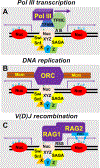Non-canonical functions of enhancers: regulation of RNA polymerase III transcription, DNA replication, and V(D)J recombination
- PMID: 38643034
- PMCID: PMC11152991
- DOI: 10.1016/j.tig.2024.04.001
Non-canonical functions of enhancers: regulation of RNA polymerase III transcription, DNA replication, and V(D)J recombination
Abstract
Enhancers are the key regulators of other DNA-based processes by virtue of their unique ability to generate nucleosome-depleted regions in a highly regulated manner. Enhancers regulate cell-type-specific transcription of tRNA genes by RNA polymerase III (Pol III). They are also responsible for the binding of the origin replication complex (ORC) to DNA replication origins, thereby regulating origin utilization, replication timing, and replication-dependent chromosome breaks. Additionally, enhancers regulate V(D)J recombination by increasing access of the recombination-activating gene (RAG) recombinase to target sites and by generating non-coding enhancer RNAs and localized regions of trimethylated histone H3-K4 recognized by the RAG2 PHD domain. Thus, enhancers represent the first step in decoding the genome, and hence they regulate biological processes that, unlike RNA polymerase II (Pol II) transcription, do not have dedicated regulatory proteins.
Keywords: DNA replication; Enhancers; RNA polymerase III; V(D)J recombination; chromatin accessibility; gene expression.
Copyright © 2024 Elsevier Ltd. All rights reserved.
Conflict of interest statement
Declaration of interests I declare no competing interests.
Figures


Similar articles
-
Insertion of an imprinted insulator into the IgH locus reveals developmentally regulated, transcription-dependent control of V(D)J recombination.Mol Cell Biol. 2015 Feb;35(3):529-43. doi: 10.1128/MCB.00235-14. Epub 2014 Nov 17. Mol Cell Biol. 2015. PMID: 25403489 Free PMC article.
-
Promoters, enhancers, and transcription target RAG1 binding during V(D)J recombination.J Exp Med. 2010 Dec 20;207(13):2809-16. doi: 10.1084/jem.20101136. Epub 2010 Nov 29. J Exp Med. 2010. PMID: 21115692 Free PMC article.
-
Stimulation of direct-repeat recombination by RNA polymerase III transcription.DNA Repair (Amst). 2009 May 1;8(5):620-6. doi: 10.1016/j.dnarep.2008.12.010. Epub 2009 Jan 24. DNA Repair (Amst). 2009. PMID: 19168400
-
Regulation of T-cell Receptor Gene Expression by Three-Dimensional Locus Conformation and Enhancer Function.Int J Mol Sci. 2020 Nov 11;21(22):8478. doi: 10.3390/ijms21228478. Int J Mol Sci. 2020. PMID: 33187197 Free PMC article. Review.
-
The Evolution of Rag Gene Enhancers and Transcription Factor E and Id Proteins in the Adaptive Immune System.Int J Mol Sci. 2021 May 31;22(11):5888. doi: 10.3390/ijms22115888. Int J Mol Sci. 2021. PMID: 34072618 Free PMC article. Review.
Cited by
-
Chromatin accessibility: biological functions, molecular mechanisms and therapeutic application.Signal Transduct Target Ther. 2024 Dec 4;9(1):340. doi: 10.1038/s41392-024-02030-9. Signal Transduct Target Ther. 2024. PMID: 39627201 Free PMC article. Review.
References
-
- Banerji J et al. (1981) Expression of a b-globin gene is enhanced by remote SV40 DNA sequences. Cell 27, 299–308 - PubMed
-
- Banerji J et al. (1983) A lymphocyte-specific cellular enhancer is located downstream of the joining region in immunoglobulin heavy chain genes. Cell 33, 729–740 - PubMed
-
- Chandler VL et al. (1983) DNA sequences bound specifically by glucocorticoid receptor in vitro render a heterologous promoter hormone responsive in vivo. Cell 33, 489–499 - PubMed
-
- Gillies SD et al. (1983) A tissue-specific enhancer element is located in the major intron of a rearranged immunoglobulin heavy chain gene. Cell 33, 717–728 - PubMed
MeSH terms
Substances
Grants and funding
LinkOut - more resources
Full Text Sources

